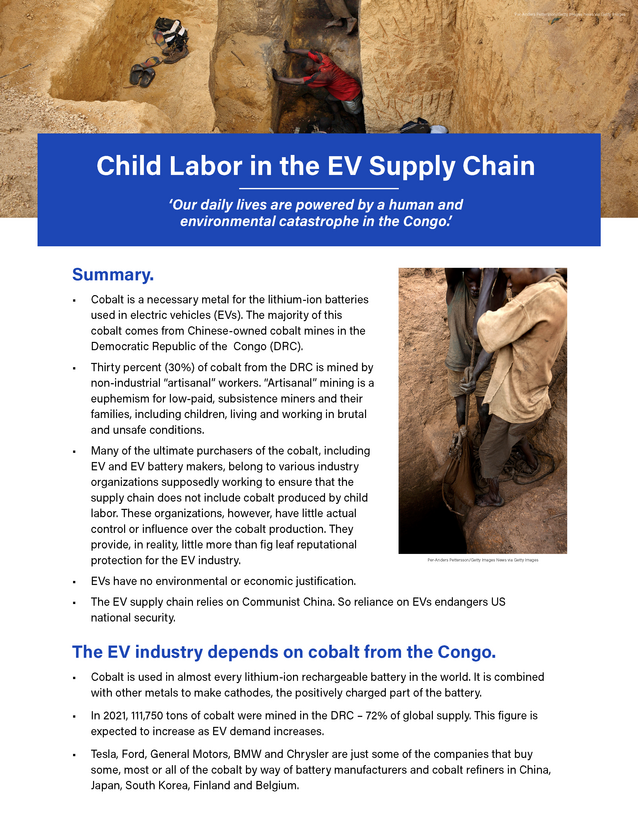YOU SHOULD SUBSCRIBE TO CLIMATE CHANGE WEEKLY.
IN THIS ISSUE:
- The High Price of Climate Alarm
- Video of the Week: Debate Champ Busts Climate Myths
- Changing Its Tune, JP Morgan Now Says Fossil Fuels Will Be Around for a While
- Poll Shows American’s Still Rank Climate Change as Low Priority
- Experimental Evidence Indicates CO2 Is Saturated, Can’t Drive Temperatures
- Podcast of the Week: The Folly of Wind and Solar to Power Pennsylvania
- Climate Comedy
- Recommended Sites
Watch ALL the Presentations by the ALL-STARS of Climate Realism at the Archive of Heartland’s 15 Climate Conferences
The High Price of Climate Alarm

It is with no small amount of pleasure that I found a media outlet acknowledging President Joe Biden’s energy and climate policies have increased American’s energy costs. The Dallas Express, a local online alternative news outlet, published a story titled “Energy Prices 30% Higher Under Biden Admin.” Unlike so much of the mainstream media, The Dallas Express didn’t expend ink trying to explain how consumers really don’t realize that the economy and their lives are better despite the higher prices, or that the costs Biden and company have added to peoples’ power bills are justified as a means of fighting climate change. Rather, the Express took a Joe Friday, “just the facts” approach, explaining:
Energy prices in the United States are wreaking havoc on budget-sensitive households, making it harder for families to save money or get ahead financially.
Since President Joe Biden took office in January 2021, Americans’ electricity bills have skyrocketed nearly 30%, or 13 times faster than in the previous seven years, according to a Wall Street Journal analysis of the latest consumer price index data.
Despite the Federal Reserve holding interest rates steady since July 2023, inflation continues to pose a problem for policymakers and households.
“There is no improvement here, we’re moving in the wrong direction,” said Bankrate chief financial analyst Greg McBride in an interview with Fox Business. “The usual trouble spots persist—shelter, motor vehicle insurance, maintenance, repairs, and service costs. Add electricity to that list, up 0.9% in March and 5% over the past year.”
Part of the reason for the surge in energy prices is due to the push to replace fossil fuels and nuclear power plants with renewable subsidies and green-energy mandates.
Of course, The Heartland Institute has been on top of this story since Biden took office. We produced Energy at a Glance Documents in 2021 and 2022 detailing the Biden policies that have resulted in higher electricity, heating, and transportation fuel prices, and how much they went up. By our calculation, after less than 2 full years in office, Biden’s climate and energy policies hare increased average household energy costs by more than $2,300.
Interviewed for an Environment & Climate News story covering the lingering high prices energy prices in 2023, Gary Stone, executive vice president of engineering at Five States Energy, said:
The Biden administration has been a continually growing disaster for the domestic oil and gas industry. Using the ‘New Green Deal’ as a basis, they have halted or delayed drilling on federal lands, attempted to restrict drilling because of allegedly endangered species, cancelled pipelines, and restricted exports of crude and processed gas liquids.
While international oil politics, production, and pricing still control a significant portion of the market, there is no doubt the policies of the Biden regime have had a huge impact on prices.” Gas prices, for instance, were far lower under the Trump administration, crude oil prices were about $30 (per barrel) lower, and gasoline was around $2 per gallon less than now, all of which immediately rose under Biden.
Instead of encouraging domestic production as Trump did, the current regime is now implementing onerous methane-emission regulations and taxes that some sources estimate will result in the abandonment of as much as 30 percent of domestic wells and greatly increase the operating costs, and reduce the life, of the remaining producers. The Biden administration will serve the ‘green gods’ even if it bankrupts much of a major industry and greatly reduces the energy available to the country.
Of course those are just the direct energy costs to drivers, businesses, renters, and homeowners, not accounting for the ripple effect higher energy prices have on energy-intensive goods like food production and delivery, chemical production, and manufacturing.
Other rarely accounted for costs of Biden’s climate obsession—one not shared by the American public, according to recent polls—stem from government spending on Biden’s climate and energy policies. The costs of these programs are borne by taxpayers and future generations who will inherit the costs Biden’s energy policies are adding to the nation’s annual deficits and long-term debt.
How much are we talking about? Well, in early April 2024, the Biden administration granted outright more than $20 billion to unaccountable climate, finance, and community activist NGOs to promote green energy adoption across the country.
Author and energy analyst Robert Bryce has calculated that the subsidies and tax credits for wind and solar power alone have ballooned from an estimated $19.9 billion in 2015 to commitments of more than $425 billion by 2033, based on newly installed, approved, and anticipated wind and solar construction.
And, in December 2023, at a conference in Dubai, Vice President Kamala Harris bragged about the administration’s commitment to spend more than $1 trillion fighting climate change—less than the country spent on Social Security in 2023, but more than we spent on defense. This is likely an underestimate as past estimates of spending on these programs have repeatedly proven to be.
Government spending and regulations are a drag on the economy, basically a hidden tax, spending money on goods and services that consumers likely wouldn’t have freely chosen to spend their own money, or companies invested in, or banks financed, in a marketplace not directed by federal mandates or influenced by federal incentives: replacing market assessments of how to balance the concerns of climate change, energy security, and economic progress with spending decisions dictated by political overlords, their crony-capitalist allies, and climate scolds.
Any way you measure it, the price tag on Biden’s climate program on the American economy and its people is quite high and growing.
Sources: Climate Realism; The Dallas Express; Environment & Climate News; Energy at a Glance; The White House; Robert Bryce
NEW: Get Climate at a Glance on your mobile device!
Video of the Week
James Taylor, president of The Heartland Institute and the founding director of Heartland’s Arthur B. Robinson Center for Climate and Environmental Policy, presents data refuting multiple climate change myths in front of a packed audience at Vineyards Country Club in Florida. Taylor covers topics such as global temperatures, sea level rise, crop production, hurricanes, and tornadoes, citing data from peer-reviewed sources in the process.
Read the brutal truth about how battery production for electric vehicles cause immense environmental destruction and human tragedy.
Changing Its Tune, JP Morgan Now Says Fossil Fuels Will Be Around for a While

JP Morgan Chase has been a leader among the banks and financial institutions fighting for the use of Environment, Social, and Governance metrics and net zero, both of which call for rapidly ending the use of fossil fuels to fight climate change. It seems the company now recognizes what climate and energy realists have long argued: fossil fuels will remain integral to continued economic progress for some time to come.
“While the target to net zero is still some time away, we have to face up to the reality that the variables have changed,” the bank’s head of global energy strategy, Christyan Malek, the lead author of a new JP Morgan energy report by JP Morgan, told the Financial Times.
The report says higher interest rates, inflation, and the wars in Ukraine and the Middle East are among the prime factors hampering the rapid adoption of policies to enforce net zero.
Interestingly, a recent Rystad Energy analysis came to the same conclusion.
“Owing to the capital-intensive (Capex) nature of renewable energy…they are inherently more susceptible to high-interest rates,” Rystad Energy’s head of renewables and power, Vegard Wiik Vollset, told Reuters.
ZeroHedge notes that the global data firm “Wood Mackenzie has also warned that higher rates are having a negative effect on the economics of wind and solar, as a 2 percent rate increase can push the levelized cost of electricity for these two sources as much as 20 percent higher.”
“Government debt is significantly greater and the geopolitical landscape is structurally different. The $3tn to $4tn it will cost each year come in a different macro environment,” Malek said.
Malek says all these factors lead him to suggest that governments cut back the rhetoric and policies that would force a premature retirement of fossil fuels, at least until the economics change.
Sources: ZeroHedge; Financial Times
Heartland’s Must-read Climate Sites



Poll Shows American’s Still Rank Climate Change as a Low Priority

Gallup Inc. is widely recognized as one of the foremost polling and advisory companies. It regularly conducts public policy surveys asking participants, often registered voters, broken down by gender, income levels, political party affiliation or leanings, and education levels, to describe what they feel are the top public policy issues or concerns, often ranking them.
Gallup’s surveys have asked about climate change as an issue for decades. While a majority or near majority of participants have pretty consistently ranked climate change as an issue of concern, they have, over the years, consistently ranked it as last or near last among the top issues of concern.
Gallup’s annual survey in 2024 polled a random sample of 1,016 adults, aged 18 and older, living in all 50 U.S. states and the District of Columbia, delivering a sampling error of ±4 percentage points.
Gallup’s 2024 Earth Day poll is consistent with past surveys. Gallup found that 42 percent of Americans surveyed worry “a great deal” about global warming or climate change, with another 20 percent worrying “a fair amount.”
Fifty-nine percent of those surveyed believe global warming has already begun to happen, but a majority (55 percent), also do not think it will pose a serious threat in their own lifetime.
When ranked against other issues confronting the nation, as Gallup states: “Environmental Worries Lag Behind Economic and Social Issues,” which is also consistent with past surveys. And all of this is despite nearly two decades of climate alarm propagandizing in the mainstream media.
“Among the leading issues confronting the nation, the environment ranks as a lesser public concern, with 37% saying they worry a great deal about environmental quality,” Gallup reports.
In fact, worry about a quality environment tied for 11th place with “the availability and affordability of energy,” out of the 14 issues of concern Gallup listed. Only race relations and unemployment at 35 percent and 33 percent, respectively, ranked lower. By contrast, more than 50 percent of those surveyed said that they worry a great deal about inflation, crime and violence, hunger and homelessness, the economy, affordable health care, and government spending. Concern about illegal immigration, drug use, the social security system, and the possibility of a terrorist attack all also ranked above concern about a quality environment.
Of course, climate change is just one environmental challenge lumped together under the category “quality of the environment.” When various environmental issues were polled individually, poll participants said pollution of drinking water; pollution of rivers, lakes, and streams; and contamination of soil and water by toxic waste were each more worrying to them than climate change. And this response comes despite the fact those topics collectively are rarely discussed by politicians, and never as an existential threat to human life, and get a fraction of the coverage climate change does.
Interestingly, Gallup reported in 2023 that concern about various environmental issues, while rising and falling year to year, has declined overall since 2000, when Gallup first started breaking down environmental issues. The number of people saying they are very worried about climate change fell from a high of 46 percent in 2020, and now sits just two points above the level of concern participants displayed when they were first asked about it in the annual poll in 2000.
Experimental Evidence Indicates CO2 Is Saturated, Can’t Drive Temperatures

A recent series of papers suggests that the world has already surpassed the level at which adding additional carbon dioxide (CO2) to the atmosphere can have no additional warming effect, “due to saturation, higher and higher concentrations do not lead to any further absorption of radiation.”
In a series of peer reviewed papers from 2020, 2022, and 2024 published in the journal Applications in Engineering Science, a team of Polish physicists examined the extent to which CO2 saturation occurs in the atmosphere, limiting its warming impact. The authors concluded that, “as a result of saturation processes, emitted CO2 does not directly cause an increase in global temperature.”
Saturation is a well-known process that occurs when no more of something (a chemical, molecule, or mixture, for example) can be absorbed, combined with, or added, or when added, has any additional effect. Imagine adding salt or sugar to a container of water; beyond some point, adding any additional salt or sugar added no longer makes the combination saltier or sweeter.
Atmospheric CO2 absorbs radiation in a particular band of frequencies in the electromagnetic spectrum. Other greenhouse gases also absorb radiation in that band. At a certain point, the atmospheric concentration of greenhouse gases absorbs the entire band of radiation, producing no more warming as additional units of CO2 or other gases that absorb the band are added.
The research paper published in 2024, based on a series of experiments and measurements, suggests that CO2 is already saturated at current levels, possibly reaching the saturation point way back at 300 ppm.
“[A]s a result of saturation processes, emitted CO2 does not directly cause an increase in global temperature,” the researchers conclude.
Theirs is not the first paper to reach this conclusion, as detailed in their paper’s literature review and at No Tricks Zone. As Kenneth Richard writes at No Tricks Zone:
This research adds another layer to more than 50 years of research on the CO2 saturation principle.
“[For example,] Schack (1972)…demonstrated that for a concentration of 0.03% of carbon dioxide in the air, the absorption process in the troposphere is saturated.”
Recently, other scientists (Chen et al., 2023) also reported that CO2 has a severely reduced effect on atmospheric transmissivity due to (a) absorption saturation (CO2 can have no effect beyond a pre-industrial concentration), and because (b) water vapor and cloud forcing overlap and thus dominate absorption in CO2’s band.
“[Transmissivity] in the CO2 band center is unchanged by increased CO2 as the absorption is already saturated…”
“[T]he water vapor and CO2 overlapping at an absorbing band prevents absorption by additional CO2.”
If this research is correct, then worries about the climate impact of adding more carbon dioxide into the atmosphere are misguided. Meaning there is no climate need to end the use of fossil fuels or for governments to impose expensive carbon rationing policies that increase poverty, energy and food costs, and premature death.
Sources: No Tricks Zone; Applications in Engineering Science
Podcast of the Week
The other day H. Sterling Burnett, director of The Heartland Institute’s Arthur B. Robinson Center for Climate and Environmental Policy was a guest on The John Steigerwald Show on AM1250 The Answer in Pittsburgh. Sterling is a frequent guest on that excellent program, and was asked on to talk about Pennsylvania’s plan to lean on solar and wind for future energy. As you might expect, Sterling explained how and why this is a bad idea, especially for resource-rich Pennsylvania.
Subscribe to the Environment & Climate News podcast on Apple Podcasts, iHeart, Spotify or wherever you get your podcasts. And be sure to leave a positive review!





























